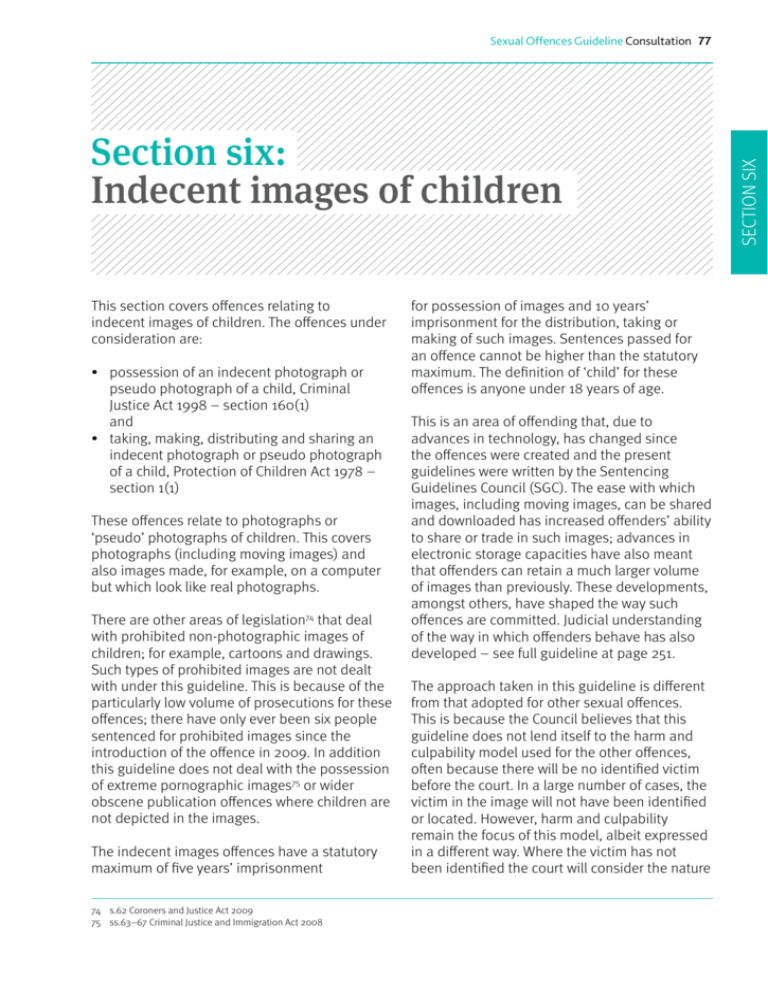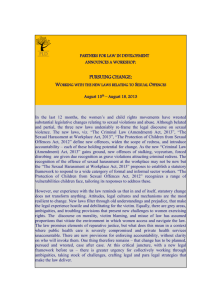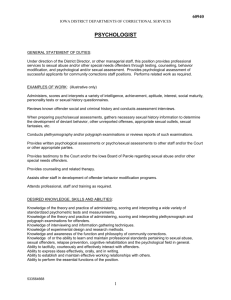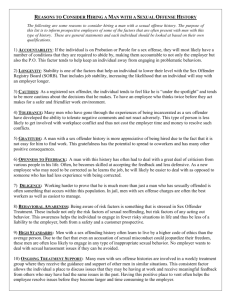
Section six:
Indecent images of children
This section covers offences relating to
indecent images of children. The offences under
consideration are:
• possession of an indecent photograph or
pseudo photograph of a child, Criminal
Justice Act 1998 – section 160(1)
and
• taking, making, distributing and sharing an
indecent photograph or pseudo photograph
of a child, Protection of Children Act 1978 –
section 1(1)
These offences relate to photographs or
‘pseudo’ photographs of children. This covers
photographs (including moving images) and
also images made, for example, on a computer
but which look like real photographs.
There are other areas of legislation74 that deal
with prohibited non-photographic images of
children; for example, cartoons and drawings.
Such types of prohibited images are not dealt
with under this guideline. This is because of the
particularly low volume of prosecutions for these
offences; there have only ever been six people
sentenced for prohibited images since the
introduction of the offence in 2009. In addition
this guideline does not deal with the possession
of extreme pornographic images75 or wider
obscene publication offences where children are
not depicted in the images.
The indecent images offences have a statutory
maximum of five years’ imprisonment
74 s.62 Coroners and Justice Act 2009
75 ss.63–67 Criminal Justice and Immigration Act 2008
for possession of images and 10 years’
imprisonment for the distribution, taking or
making of such images. Sentences passed for
an offence cannot be higher than the statutory
maximum. The definition of ‘child’ for these
offences is anyone under 18 years of age.
This is an area of offending that, due to
advances in technology, has changed since
the offences were created and the present
guidelines were written by the Sentencing
Guidelines Council (SGC). The ease with which
images, including moving images, can be shared
and downloaded has increased offenders’ ability
to share or trade in such images; advances in
electronic storage capacities have also meant
that offenders can retain a much larger volume
of images than previously. These developments,
amongst others, have shaped the way such
offences are committed. Judicial understanding
of the way in which offenders behave has also
developed – see full guideline at page 251.
The approach taken in this guideline is different
from that adopted for other sexual offences.
This is because the Council believes that this
guideline does not lend itself to the harm and
culpability model used for the other offences,
often because there will be no identified victim
before the court. In a large number of cases, the
victim in the image will not have been identified
or located. However, harm and culpability
remain the focus of this model, albeit expressed
in a different way. Where the victim has not
been identified the court will consider the nature
SECTION SIX
Sexual Offences Guideline Consultation 77
SECTION SIX
78 Sexual Offences Guideline Consultation
and level of harm caused by indecent images.
The victim who has been abused to create the
image is subjected also to further harm due to
the image being recorded and viewed. There is
also further harm due to the fact that viewing the
images creates a market and demand for these
pictures and so leads to further abuse. Mr Justice
Keith articulates the approach taken by the
court to harm in the case R v Beaney76 where he
states:
Role of the offender
The Council believes that one of the principal
factors to be considered by the sentencer is
the offender’s role and involvement with the
images. Although the discussion around role
principally focuses on computer-related crime,
it should not be overlooked that a variety
of media and methods can be used in the
creation, distribution and possession of indecent
photographs of children.
“The serious psychological injury which
they [the children in the picture] would
be at risk of being subjected to arises not
merely from what they are being forced
to do but also from their knowledge that
what they are being forced to do would
be viewed by others. It is not difficult
to imagine the humiliation and lack of
self-worth they are likely to feel. It is not
simply the fact that without a market for
these images the trade would not flourish.
If people… continue to download and
view images of this kind… the offences
which they commit can properly be said
to contribute to the psychological harm
which the children in those images would
suffer by virtue of the children’s awareness
that there were people… watching them
forced to pose and behave in this way.”
• Possession of images: offenders will be
placed in this category if they possess images
but there is no evidence of distributing,
possession with a view to distributing, or
involvement in the production of the image.
‘Making’ of an image by downloading
should be distinguished from the category
‘production/taking’ which is discussed
below. If ‘making’ is charged in relation
to downloading and does not involve
production/taking of the image then
for the purposes of sentencing ‘making’
by downloading should be treated as
possession.
• Distribution: includes both actual distribution
and possession of the images with a view to
distributing them or showing them or making
them available to others.77
• Production/taking: includes an offender
being involved in the actual taking or
making of an image at source; in other
words involvement in producing the original
image. This is to be distinguished from
‘making’ by downloading, discussed above
under possession. Any offender found guilty
of production/taking will be placed in the
highest category.
STEP ONE
Determining the offence category
The Council has included what it believes to be
the main factual elements of the offence. The
Council has chosen to determine the offence
category firstly, by identifying the role of the
offender (broadly reflecting culpability) and
secondly, by considering the severity of the
image (broadly representing harm).
76 [2004] EWCA Crim 449
77 s.1(1)(c) Protection of Children Act 1978
In order to provide clarity the Council is
proposing to include guidance in the text
clarifying how these categories should be used
– see full guideline at page 251.
Severity of the image
The existing SGC guideline sets out five levels of
prohibited image based on those set out in the
judgment in Oliver78 which adapted the image
classification found in the Copine scale.79 The
image levels used are:
• level one – images depicting erotic posing
with no sexual activity;
• level two – non-penetrative sexual activity
between children, or solo masturbation by a
child;
• level three – non-penetrative sexual activity
between adults and children;
• level four – penetrative sexual activity
involving a child or children or both children
and adults; and
• level five – sadism or penetration of, or by, an
animal.
The Council is sensitive to the fact that
classification of images can be a difficult and
resource intensive job for the investigating and
prosecuting authorities. The Council is also
aware that the images before the court may give
only a partial indication of the abuse suffered
by the victim in the image, and image level
alone does not give a complete account of the
offender’s behaviour. However, the court can
only sentence what is before it and the Council
believes that, despite the limitations around
using image level, the severity of the sexual
offence depicted in the image can be an initial
guide to the harm that will have been suffered
by the victim depicted.
Given the challenges presented by the
classification of images, the Council proposes
the levels of images can be simplified further.
The proposed levels are set out below.
• Category A: ‘Images involving penetrative
sexual activity’; ‘possession of images
involving sexual activity with an animal or
sadism’. The Council believes that any image
showing a child involved in penetrative
sexual activity should be placed in the
highest category. In line with the other
sexual offences involving a child discussed
in section five page 36, it is envisaged this
would involve penetration of the vagina
or anus (using body or object) and penile
penetration of the mouth in either case by,
or of, the victim. It is not proposed that a
distinction is made between penetrative
activity between an adult and child and
penetrative activity between children.
It is also intended that category A includes
images involving sexual activity with an
animal or sadism. In the existing SGC
guideline, ‘penetrative activity and sadism’
and ‘penetration of, or by, an animal’ are
expressed as different levels of image
(four and five respectively) but they attract
exactly the same sentence starting points
and ranges. The Council has therefore
placed both of these into category A.
The Council has changed the wording
‘penetration of, or by, an animal’ to ‘sexual
activity involving an animal’ to ensure that
it covers images involving non-penetrative
activity and addresses a difficulty that
currently arises. This difficulty is highlighted
in the CPS charging guidance in relation to
the current categorisation which states:
“A question is raised as to what
happens if a photograph shows a
non-penetrative sexual act involving
an animal (for example an animal
licking the sexual organs of a child).
A strict interpretation of level five would
suggest that it could not come within
that level but neither would it fit into
any other level other than, conceivably,
level one”80
78 [2003] 1 Cr App R 28 CA
79 The Copine project (Combating Paedophile information networks in Europe) at the University of Cork developed a scale to categorise child abuse
images. It has ten levels and was originally developed to look at the psychological approach to pictures rather than for use in courts.
80 CPS charging guidance indecent photographs of children http://www.cps.gov.uk/legal/h_to_k/indecent_photographs_of_children/#a03
SECTION SIX
Sexual Offences Guideline Consultation 79
SECTION SIX
80 Sexual Offences Guideline Consultation
• Category B: ‘Possession of images involving
non-penetrative sexual activity’. This category
combines the SGC levels two and three.
The SGC made a distinction between nonpenetrative sexual activity between children
(or a child on their own) and non-penetrative
sexual activity between an adult and a child.
The Council is of the opinion that even if the
image does not contain an adult, this does
not mean that an adult was not involved in
making it or otherwise exploiting the victim in
order to generate the image. In addition, the
ongoing victimisation of the child that flows
from the image being recorded and viewed
will be great even if there is not an adult
in the picture. The Council is aware of the
intensive law enforcement resources needed
to classify images; the Council has taken
the view that a distinction between images
involving just children and those involving
adults and children is not required for
sentencing purposes as both create similar
levels of harm and culpability. The Council
is, therefore, consulting on the basis that all
non-penetrative sexual activity should be
dealt with using the same starting point and
category ranges.
• Category C: ‘Images of erotic posing’.
This category is included to capture other
prohibited images which do not fall within A
and B above. ‘Erotic posing’ is a term used
in the SGC guideline but may be misleading.
There may be cases where an image is not
posed or ‘erotic’ but could still be deemed
indecent, for example, a naked picture of a
child not engaged in sexual activity but with
a focus on the child’s genitals. The Council
invites views on whether this category
could be defined differently to better reflect
indecent images not captured in A and B.
It will be noted that the levels have been
labelled as A, B and C rather than numbered.
The reason for this is that for a number of years
those working in the criminal justice system
have been used to referring to the image
levels by the current 1 to 5 labelling. In all the
Sentencing Council guidelines, the highest
starting points and ranges are found in category
1. However, under the current SGC grading
system based on Oliver, category 1 is the lowest
starting point and range. The Council feels it
would be confusing to reverse the order and so
is proposing to use A, B and C.
Q39
Do you agree with the proposed
rationalisation of the current levels
1 to 5?
It will be rare that the court will sentence an
offender for only one level of image as most
offenders have collections containing mixed
levels of images. This can cause difficulties for
sentencers and the Council is proposing that
for ‘mixed collections’ the highest category of
image level present in the collection will initially
determine the appropriate starting point and
range. If, however, to use that category will be
unrepresentative of the offender’s conduct, a
lower category may be appropriate. However, it
is suggested that a lower category is unlikely to
be appropriate if the offender has produced or
taken higher level material. To assist sentencers
in dealing with mixed collections it is suggested
that an explanation is included in the guideline.
The wording proposed is:
“In most cases the intrinsic character of
the most serious of the offending images
will initially determine the appropriate
category. If, however, the most serious
images are unrepresentative of the
offender’s conduct a lower category may
be appropriate. A lower category will not,
however, be appropriate if the offender
has produced or taken (i.e. photographed)
images of a higher category.”
Q40
Do you agree with the approach
suggested to dealing with mixed
collections? If not, please state why.
An important difference from the existing
SGC guideline is that the quantity of material
will not be used to determine the category at
step one. Currently the SGC classes quantity
by reference to a ‘small number’ and ‘large
number’ to determine sentence starting points
and ranges for different levels of images. These
terms are not, however, defined and this has
caused difficulties for judges in assessing what
constitutes ‘small’ or ‘large’. The Council has
formed the view that the number of images is
not necessarily an indicator of the offender’s
culpability; what the offender has done with the
images is a better indicator of this. For example,
an offender who has produced even a small
number of images attracts a higher starting
point than an offender in possession of the
same number.
However, as a large volume of images may
provide an additional indicator of increased
culpability in some cases, it is included as an
aggravating feature in step two, allowing the
court to move up from the starting point in
appropriate cases. This is discussed at page 83.
In light of the points raised above, the proposed
structure at step one is therefore:
Possession
Distribution*
Production**
Category A
(previously
levels 4 and 5)
Possession of images involving
penetrative sexual activity
Sharing images involving
penetrative sexual activity
Creating images involving
penetrative sexual activity
Possession of images involving
sexual activity with an animal
or sadism
Sharing images involving
sexual activity with an
animal or sadism
Creating images involving
sexual activity with an
animal or sadism
Category B
(previously
levels 2 and 3)
Possession of images involving
non-penetrative sexual activity
Sharing of images involving
non-penetrative sexual
activity
Creating images involving
non-penetrative sexual
activity
Category C
(previously
level 1)
Possession of images of erotic
posing
Sharing of images of erotic
posing
Creating images of erotic
posing
* Distribution includes possession with a view to distributing or sharing images
** Production includes the taking or making of any image at source, i.e. the original image
Making an image by simple downloading should be treated as possession for the purposes of sentencing
Q41
Do you agree with the use of role
and the use of image levels A, B
and C to determine the category of
offence and the exclusion of volume
at step one? If not, please give
reasons.
Q42
Do you have any suggestions for
how level C ‘erotic posing’ could be
re-labelled?
SECTION SIX
Sexual Offences Guideline Consultation 81
82 Sexual Offences Guideline Consultation
Attempts to dispose of or conceal evidence
SECTION SIX
STEP TWO
Starting points and category ranges
Abuse of position of trust
Child depicted known to the offender
Once the appropriate category has been
determined using role and image level as
described above, the court is asked to identify
whether there are any additional factors which
might aggravate or mitigate the offence. This
would then lead the court to decide whether
the sentence should be adjusted upwards or
downwards within the relevant range from the
starting point set out in the guideline.
It is important to highlight that the list of factors
at step two is non-exhaustive. The Council’s
intention is to set out factors that are likely to be
relatively common to these offences to ensure
that they are considered equally by all courts. It
is also important to note that the list of factors is
not a checklist; however, where any such factor
is present the court can take it into account
rather than relying on volume alone.
The table below sets out the proposed
aggravating factors.
Aggravating factors
Statutory aggravating factors
Previous convictions, having regard to a) the nature
of the offence to which the conviction relates and its
relevance to the current offence; and b) the time that
has elapsed since the conviction
Offence committed whilst on bail
Other aggravating factors
Age and/or vulnerability of the child depicted*
Visible physical pain suffered by child depicted
Period over which images were possessed, made or
distributed
Large volume of images possessed, distributed or
produced/taken
Placing images where there is the potential for a high
volume of viewers
Collection includes moving images
Active involvement in a network or process that
facilitates or commissions the creation or sharing of
indecent images of children
Deliberate or systematic searching for images portraying
young children, category A images or the portrayal of
familial sexual abuse
Systematic storage of collection
*
Age and/or vulnerability of the child should be given significant
weight. In cases where the actual age of the victim is difficult to
determine sentencers should consider the development of the child
(infant, pre-pubescent, post-pubescent)
• ‘Previous convictions’ and ‘offence committed
whist on bail’ – see discussion at page 23.
• ‘Age and/or vulnerability of the child
depicted’ should be given significant weight.
In cases where the actual age of the victim
is difficult to determine sentencers should
consider the development of the child
(infant, pre-pubescent, post-pubescent).
This is included to deal with cases where,
for example, the victim has not been
identified and so the court cannot know
the actual age of the child. The current
SGC guideline includes a suggestion that
starting points should be higher where the
subject of the photograph is under the age
of 13. The Council recognises the difficulty
for sentencers in ascribing an age to an
unidentified victim and does not believe
that there should be a strict cut-off in age
terms when assessing the harm caused
to the victim. It is recommending that an
assessment of the developmental stage of
the child will assist the sentencer rather than
a reference to an actual age.
• ‘Visible physical pain suffered by the child
depicted’ is intended to cover the increased
harm to the victim demonstrated by the
victim visibly responding to physical pain.
• ‘Period over which the images were
possessed, made or distributed’ builds a
more comprehensive picture of the offender’s
behaviour and may be relevant to risk.
Where an offender is claiming previous
good character as mitigation, but has been
involved with such images over a long
period, sentencers may wish to take this into
consideration in determining whether any
weight is given to previous good character.
• ‘Large volume of images possessed,
distributed or produced/taken’ allows the
volume of images to be taken into account
where it is a significant consideration.
There will be cases when a large volume
of images is a very significant aggravating
factor especially where the material is being
distributed or produced.
• ‘Placing images where there is the potential
for a high volume of viewers’ has been
included to deal with the increased harm to
the victim where an offender puts images in
a place where, potentially, a large number
of people could access those images. It is
intended to reflect the emotional distress
caused to such a victim by the potential
for large numbers of unknown individuals
viewing them in a vulnerable state.
• ‘Collection includes moving images’. The
Council feels that one moving image of, for
example, 20 minutes does not equate directly
with one still image as there may be more
than one abusive incident which takes place
during that period. Potentially, hundreds
of still images may be taken from the one
20-minute film. In order to reflect this, the
Council is recommending the inclusion of
moving imagery as an aggravating feature.
• ‘Attempts to dispose of or conceal evidence’.
This is designed to address issues arising
from offenders’ increasingly sophisticated
efforts to prevent images being discovered.
It ranges from the mislabelling of files to give
the impression that the content is lawful to
advanced encryption techniques.
• ‘Abuse of position of trust’ and ‘child known
to the offender’ are both aggravating factors
because both indicate the close proximity
of the offender to the commission of the
abuse. It will be more common that the
victim will not have been identified by the
court but where knowledge of the child or
abuse of trust is established evidentially it
demonstrates increased culpability on the
part of the offender due to the targeting or
manipulation of the victim.
• ‘Active involvement in a network or
process that facilitates or commissions the
creation or sharing of indecent images of
children’. Where such a factor is present it
demonstrates a higher level of culpability on
the part of the offender.
• ‘Deliberate or systematic searching for
images portraying young children, category
A images or the portrayal of familial sexual
abuse’. Where such searches are uncovered
by forensic examination, they can reveal
that the offender has been searching for
higher levels of image than those recovered.
Whilst the offender can only be sentenced
for the images recovered, such searches can
assist the court in assessing the offender’s
culpability.
• ‘Systematic storage of collection’. It has
already been discussed above that attempts
made to conceal may aggravate an offence.
However, systematic storage could also
increase the offender’s culpability where it
demonstrates the deliberate thought and
effort invested by the offender in collecting
specific indecent images.
SECTION SIX
Sexual Offences Guideline Consultation 83
SECTION SIX
84 Sexual Offences Guideline Consultation
Mitigation
The mitigating factors below have already been
discussed in previous guidelines and a full
discussion of these can be found at page 24.
Mitigating factors
No previous convictions or no relevant/recent
convictions
Remorse
Previous good character and/or exemplary conduct
Determination and/or demonstration of steps taken to
address sexual behaviour
Age and/or lack of maturity where it affects the
responsibility of the offender
Mental disorder or learning disability, where linked to
the commission of the offence
Q43
Do you agree with the aggravating
and mitigating factors proposed at
step two for the indecent images
offences? If not, please specify
which you would add or remove
and why.
Sentence levels for indecent images of
children
The maximum sentence available for possession
of indecent images is five years’ imprisonment
and 10 years’ imprisonment for distribution and
production.
The discussion at page 80 sets out the
difficulties with sentencing for mixed collections.
The approach proposed by the Council is that
the most severe images should be used as an
initial starting point.
For the highest category of images (A) a
custodial option is recommended as a starting
point in all cases whether the offender has
been charged with possession, distribution
or production. Where an offender has been
involved in the taking or making of an image at
source and this involves penetration, sadism or
an animal, then the Council has recommended
a range that goes towards the very top end
of the 10-year ceiling set by the statute and a
starting point of 6 years with a range of 4–9
years is recommended. For all the image level A
categories a custodial starting point has been
recommended.
Level B images also attract a custodial starting
point under the proposed guidelines.
The Council has moved away from the very
short custodial sentences recommended in the
existing SGC guideline; for example, currently
four weeks is available in two of the categories.
The Council does not believe that such short
sentences are appropriate because of the very
limited work the prison authorities would be
able to do to address the behaviour of the
offender in such a short period.
It will be seen that a non-custodial starting point
is recommended for possession and distribution
of level C images and for possession of level
B images. Section two of the consultation
– page 10 – sets out a discussion on the
purposes of sentencing and the importance
of public protection when sentencing sexual
offences. For offences involving indecent
images, there may be cases where the sentencer
considers that a lengthy community order
with a sexual offences treatment programme,
such as the i-sotp81 programme (specifically
designed to treat internet offenders), will be
more appropriate than a very short custodial
sentence. Such an intensive communitybased order may be more likely to achieve
the purposes of sentencing and of protecting
the public because the offender’s thinking
and behaviour will be better addressed via
81 i-sotp (Internet Sex Offender Treatment Programme) is a programme designed to explore and address internet sex offending; the aim is to
reduce the risk of further similar offending and, like other sex offender programmes, increases the offenders understanding of the impact of their
offending on others, including their victims
treatment and the degree of risk posed to the
community by the offender can be closely
monitored. However, the Council has also
deliberately included a custodial option as part
of the sentencing range in every category to
ensure that sentencers retain such an option
Category A
Category B
Category C
in appropriate cases. This is a change from
the existing SGC guidelines where only a
non‑custodial option is available for possession
of the lowest level. The proposed sentence
starting points and ranges are:
Possession
Distribution
Production
Starting point
1 year’s custody
Starting point
3 years’ custody
Starting point
6 years’ custody
Category range
26 weeks’ – 2 years’ custody
Category range
2 – 5 years’ custody
Category range
4 – 9 years’ custody
Starting point
26 weeks’ custody
Starting point
1 year’s custody
Starting point
2 years’ custody
Category range
High level community order –
18 months’ custody
Category range
26 weeks’ –
2 years’ custody
Category range
1 – 4 years’ custody
Starting point
High level community order
Starting point
13 weeks’ custody
Starting point
18 months’ custody
Category range
Medium level community order –
26 weeks’ custody
Category range
High level community order –
26 weeks’ custody
Category range
1 – 3 years’ custody
Section 2 at page 11 includes an explanation of
the additional orders that a court can impose
when an offender is convicted of sexual
offences. Sentencers will wish to consider
carefully which orders to impose for these
offences, particularly where the offender is
placed on a community order. For example, the
court could impose a sexual offences prevention
order with a condition that the offender is
prevented from accessing the internet unless the
police are given access to the computer history.
In addition to the community order, a sexual
offences prevention order can provide a useful
additional safeguard.
Q44
Please give your views on the
proposed sentence levels (starting
points and ranges) for this offence.
If you disagree with the levels
stated please give reasons why.
SECTION SIX
Sexual Offences Guideline Consultation 85







